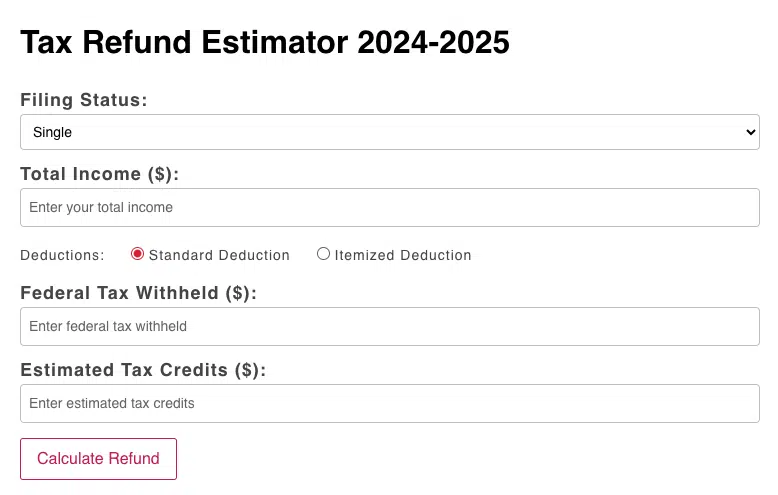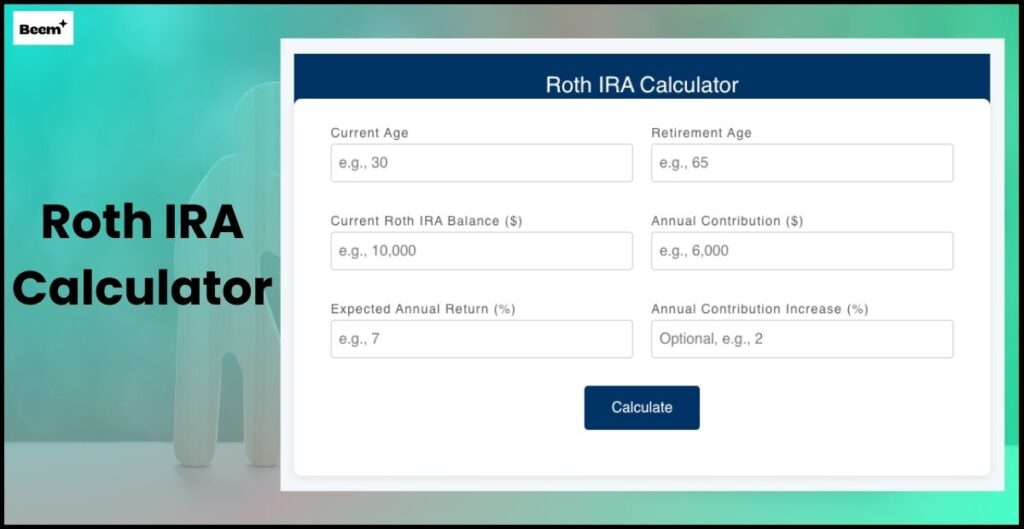Tax Refund Estimator 2024-2025
As the tax season approaches, taxpayers across the country are buzzing with questions about their potential refunds, liabilities, and overall tax scenarios. With constant changes in tax laws and adjustments to standard deductions, it’s more important than ever to have a reliable tool to help you estimate your tax refund.
In this blog, we’ll dive deep into the Tax Refund Estimator Calculator for 2024-2025—a user-friendly, yet powerful tool designed to give you a snapshot of your potential tax outcomes.
Whether you’re a seasoned filer or a first-timer, this guide will help demystify the tax refund estimation process.
Tax season can be a stressful time. The uncertainty surrounding how much tax you owe—or how much refund you’ll receive—can lead to sleepless nights. But what if you could get a clear, estimated picture of your tax situation before you even file your returns?
That’s exactly what a Tax Refund Estimator Calculator offers. With 2024-2025 bringing its own set of tax law changes and updates to standard deduction figures, this calculator is your first line of defense against surprises when tax day rolls around.
In this guide, we will take a comprehensive look at the Tax Refund Estimator Calculator. We will discuss its features, benefits, and the step-by-step process involved in using it effectively.
We will also provide practical examples to illustrate how different scenarios affect your refund or amount due.
Understanding Tax Refunds and Their Importance
A tax refund is essentially the amount of money that the government returns to you if you’ve overpaid your taxes throughout the year.
Overpayments typically occur when your employer withholds more tax from your paycheck than your final tax liability requires.
On the flip side, if not enough tax is withheld, you might owe additional money when you file your return.
Tax Refund Estimator 2024-2025
Key Reasons to Understand Your Tax Refund:
Budgeting: Knowing whether you’ll receive a refund or owe additional taxes can significantly impact your financial planning.
Avoiding Surprises: An estimate helps you prepare for a tax bill or plan how to best utilize a refund.
Financial Decision Making: Whether you’re planning a major purchase, saving for retirement, or simply want to better manage your cash flow, understanding your tax refund can help you make informed decisions.
With tax laws that change year to year, having a reliable tool to estimate your refund is crucial. This is where the Tax Refund Estimator Calculator steps in as a user-friendly solution.
What Is a Tax Refund Estimator Calculator?

A Tax Refund Estimator Calculator is an online tool designed to help taxpayers approximate their tax refunds or amounts owed before filing their returns.
It takes into account various inputs such as your total income, filing status, deductions (either standard or itemized), tax credits, and the amount of tax already withheld from your paychecks.
Key Features Include:
Filing Status Options: Choices such as Single, Married Filing Jointly, Married Filing Separately, and Head of Household.
Income Inputs: You can input your total income for the year, which forms the basis for the calculation.
Deduction Choices: The tool allows you to choose between taking the standard deduction or itemizing your deductions.
Tax Credits and Withholding: Inputs for federal tax withheld and any applicable tax credits ensure that your estimate reflects all variables.
The calculator uses a simplified progressive tax bracket system to estimate your tax liability. While real-life tax calculations can be complex, involving numerous credits and adjustments, these estimators offer a close approximation that helps in financial planning.
How Does the Tax Refund Estimator Calculator Work?
At its core, the Tax Refund Estimator Calculator uses a few simple steps to arrive at an estimated tax refund:
Input Gathering: Users provide essential information such as their filing status, total income, deduction type (standard or itemized), the amount of tax withheld, and applicable tax credits.
Deduction Application: Depending on the selected deduction type, the calculator subtracts either the standard deduction (with preset values based on filing status) or the user-provided itemized deductions from the total income to determine the taxable income.
Tax Calculation: The taxable income is then applied to the appropriate tax brackets. For example, if you are a single filer, your income is taxed progressively:
- The first portion of income is taxed at 10%.
- The next portion is taxed at 12%, and so on. This method replicates the actual tax liability calculation used by the IRS.
Refund or Liability Determination: After calculating the tax liability, the calculator subtracts this amount from the sum of the federal tax withheld and any applicable tax credits. The result will indicate either a refund (if the withheld amount exceeds the tax liability) or an additional tax owed.
This process is streamlined and designed to provide you with a near-accurate picture of your tax scenario. However, it’s important to note that while these calculators are incredibly useful, they are estimations. For a precise calculation, consulting with a tax professional or using official tax software is advisable.
Tax Refund Estimator 2024-2025
Step-by-Step Guide to Using the Calculator
Let’s walk through the process of using the Tax Refund Estimator Calculator for 2024-2025:
Step 1: Select Your Filing Status
The first step is to choose your filing status. Your filing status determines which tax brackets and standard deduction amounts apply to you.
The common options include:
- Single: For individuals who are not married.
- Married Filing Jointly: For married couples who file together.
- Married Filing Separately: For married couples who file separate returns.
- Head of Household: For unmarried individuals who provide a home for a dependent.
Step 2: Enter Your Total Income
Input your total income for the tax year. This figure should include wages, salaries, bonuses, and any other taxable income you have received. It forms the foundation of your tax calculation.
Step 3: Choose Between Standard or Itemized Deductions
Decide whether you’ll be taking the standard deduction or if you plan to itemize your deductions:
- Standard Deduction: Pre-set amounts based on your filing status (for example, $14,000 for a single filer, $28,000 for married filing jointly for 2024-2025).
- Itemized Deductions: If you have deductible expenses that exceed the standard deduction, such as mortgage interest, medical expenses, or charitable contributions, you can enter this figure instead.
If you choose itemized deductions, the calculator will prompt you to enter the total amount of these deductions.
Step 4: Input Your Federal Tax Withheld
Enter the total amount of federal tax that has been withheld from your paychecks throughout the year. This figure can typically be found on your W-2 forms.
Step 5: Include Any Tax Credits
Tax credits directly reduce your tax liability, so it’s important to include any credits you’re eligible for. Common credits include the Earned Income Tax Credit (EITC), Child Tax Credit, and education-related credits.
Step 6: Calculate Your Estimated Refund
Once you’ve input all the necessary information, click the “Calculate Refund” button. The calculator will then:
- Subtract your deductions from your total income to arrive at your taxable income.
- Apply the appropriate tax rates to determine your tax liability.
- Compare the tax liability to the sum of the federal tax withheld and your tax credits.
The final result will show either an estimated refund (if you overpaid) or the amount you owe.
Real-World Examples Of Tax Refund Estimator Tool
To illustrate how the Tax Refund Estimator Calculator works in different scenarios, let’s walk through a few examples.
Example 1: Single Filer with Standard Deduction
Scenario:
- Filing Status: Single
- Total Income: $60,000
- Deduction Type: Standard Deduction
- Federal Tax Withheld: $8,000
- Tax Credits: $500
Calculation Breakdown:
- Determine Deduction:
For a single filer in 2024-2025, the standard deduction might be around $14,000. - Calculate Taxable Income:
- Total Income: $60,000
- Standard Deduction: $14,000
- Taxable Income: $60,000 – $14,000 = $46,000
- Apply Tax Brackets (Simplified Example):
Let’s assume the tax brackets for a single filer work as follows (these are example values):- 10% on income up to $11,000:
Tax on first $11,000 = 0.10 × $11,000 = $1,100 - 12% on the remaining income:
Income left = $46,000 – $11,000 = $35,000
Tax on remaining income = 0.12 × $35,000 = $4,200 - Total Estimated Tax Liability: $1,100 + $4,200 = $5,300
- 10% on income up to $11,000:
- Estimate Refund or Amount Owed:
- Federal Tax Withheld: $8,000
- Tax Credits: $500
- Total Credits/Payments: $8,000 + $500 = $8,500
- Refund = Total Payments – Tax Liability = $8,500 – $5,300 = $3,200 Refund
In this scenario, the estimator predicts that you would receive an estimated refund of $3,200.
Example 2: Married Filing Jointly with Itemized Deductions
Scenario:
- Filing Status: Married Filing Jointly
- Total Income: $120,000
- Deduction Type: Itemized Deductions
- Itemized Deduction Amount: $25,000
- Federal Tax Withheld: $15,000
- Tax Credits: $1,000
Calculation Breakdown:
- Determine Deduction:
Instead of using the standard deduction (which might be around $28,000 for married couples filing jointly), you choose to itemize your deductions, which total $25,000 in this case. - Calculate Taxable Income:
- Total Income: $120,000
- Itemized Deductions: $25,000
- Taxable Income: $120,000 – $25,000 = $95,000
- Apply Tax Brackets (Simplified Example):
Assume the tax brackets for married filing jointly are:- 10% on income up to $22,000:
Tax on first $22,000 = 0.10 × $22,000 = $2,200 - 12% on the next portion up to $89,450:
Income left = $95,000 – $22,000 = $73,000
Tax on remaining income = 0.12 × $73,000 = $8,760 - Total Estimated Tax Liability: $2,200 + $8,760 = $10,960
- 10% on income up to $22,000:
- Estimate Refund or Amount Owed:
- Federal Tax Withheld: $15,000
- Tax Credits: $1,000
- Total Credits/Payments: $15,000 + $1,000 = $16,000
- Refund = Total Payments – Tax Liability = $16,000 – $10,960 = $5,040 Refund
This example shows how even when opting for itemized deductions, you could still receive a significant refund if the tax withheld and credits exceed your calculated liability.
Example 3: Head of Household Scenario
Scenario:
- Filing Status: Head of Household
- Total Income: $80,000
- Deduction Type: Standard Deduction
- Federal Tax Withheld: $9,000
- Tax Credits: $750
Calculation Breakdown:
- Determine Deduction:
For a Head of Household filer, the standard deduction might be around $20,000. - Calculate Taxable Income:
- Total Income: $80,000
- Standard Deduction: $20,000
- Taxable Income: $80,000 – $20,000 = $60,000
- Apply Tax Brackets (Simplified Example):
For a Head of Household, assume the brackets are:- 10% on income up to $15,700:
Tax on first $15,700 = 0.10 × $15,700 = $1,570 - 12% on the next portion up to $59,850:
Income left = $60,000 – $15,700 = $44,300
Tax on remaining income = 0.12 × $44,300 = $5,316 - Total Estimated Tax Liability: $1,570 + $5,316 = $6,886
- 10% on income up to $15,700:
- Estimate Refund or Amount Owed:
- Federal Tax Withheld: $9,000
- Tax Credits: $750
- Total Credits/Payments: $9,000 + $750 = $9,750
- Refund = Total Payments – Tax Liability = $9,750 – $6,886 = $2,864 Refund
These examples underscore how different scenarios, including varying income levels, filing statuses, and deduction choices, impact your final tax outcome.
Advantages and Limitations of the Estimator Calculator
Advantages
Ease of Use: The calculator is designed with a user-friendly interface that makes it easy for anyone—even those with limited tax knowledge—to use it effectively.
Quick Estimates: Instead of spending hours on manual calculations or waiting for a tax professional’s advice, you can get an estimate in minutes.
Planning Ahead: Knowing your potential refund or amount due helps you budget better. Whether you need to save for a big purchase or prepare for a tax bill, the estimator provides critical insight.
Educational Value: By inputting different scenarios (e.g., standard vs. itemized deductions), you learn more about how each factor impacts your overall tax liability.
Limitations
Simplification: The estimator uses simplified tax brackets and does not account for all nuances of the tax code, such as specific credits, deductions, or additional taxes (e.g., self-employment tax).
Estimation Only: While the tool provides a close approximation, it is not a substitute for professional tax advice or comprehensive tax software that accounts for all individual circumstances.
Yearly Adjustments: Tax laws and deduction amounts can change frequently. Ensure that the calculator is updated with the latest tax information for 2024-2025 to maintain accuracy.
No State Taxes: Most online tax refund calculators focus on federal taxes. If you need an estimate that includes state tax liabilities or refunds, you might need to consult additional resources.
Tips for Maximizing Your Tax Refund
While the Tax Refund Estimator Calculator provides a snapshot of your tax situation, there are additional strategies you can consider to potentially increase your refund or reduce your tax liability:
Adjust Your Withholding: If you consistently receive a large refund, it may indicate that too much tax is being withheld from your paycheck. Adjusting your withholding can provide you with more take-home pay throughout the year.
Keep Track of Deductions: Whether you plan to itemize or take the standard deduction, keeping detailed records of your expenses (such as charitable contributions, medical expenses, and mortgage interest) can help you maximize your deductions.
Explore Tax Credits: Tax credits can significantly reduce your tax liability. Familiarize yourself with credits such as the Child Tax Credit, Earned Income Tax Credit, and education-related credits, and ensure you claim any that apply to your situation.
Consult a Tax Professional: Especially if your financial situation is complex, working with a tax professional can help ensure that you’re taking advantage of all available deductions and credits.
Stay Informed: Tax laws are subject to change. Keeping up with new regulations and standard deduction adjustments can help you plan ahead and make informed decisions.
Conclusion
The Tax Refund Estimator Calculator for 2024-2025 is an essential tool for anyone looking to get a head start on their tax planning. By inputting key information such as your total income, filing status, deductions, and tax credits, you can obtain a quick, near-accurate snapshot of your potential refund or tax liability. This not only helps you avoid surprises come tax day but also empowers you to make informed financial decisions throughout the year.
While no estimator can replace the nuance of a detailed tax return prepared by a professional, this tool offers an excellent starting point for understanding your tax situation. Whether you’re a single filer, married, or filing as head of household, the calculator adapts to your unique circumstances, giving you the insights needed to plan your finances effectively.
Remember, tax laws can be complex and subject to change. It’s always a good idea to verify your estimates with the latest IRS guidelines or consult a tax professional for personalized advice. With the right tools and knowledge at your fingertips, you can navigate tax season with confidence and clarity.
Take the time to review your financial data, experiment with different scenarios, and stay informed about tax law updates. With these strategies, you can maximize your refund and ensure that you’re not leaving money on the table.
Happy estimating, and here’s to a smooth and successful tax season in 2024-2025!
Frequently Asked Questions (FAQs) About Tax Refund Estimator
What is a Tax Refund Estimator Calculator?
A Tax Refund Estimator Calculator is an online tool that estimates your potential tax refund or amount due by using inputs such as your income, deductions, tax withheld, and tax credits. It provides an approximate calculation of your tax liability based on current tax laws.
How Accurate Are These Calculators?
While these calculators provide a good estimate of your tax situation, they are simplified models. They may not capture every nuance of the tax code, such as specific deductions or credits, and are not a substitute for professional tax advice. However, they are very useful for budgeting and financial planning purposes.
Do I Need to Use the Same Tax Brackets as the IRS?
The calculator uses simplified tax brackets that approximate the IRS tax brackets for the 2024-2025 period. While these numbers are close, they might not match every detail of the official tax tables. Always verify with the latest IRS information or consult a tax professional if precision is critical.
Can I Use This Calculator if I Have Multiple Income Sources?
Yes, the calculator is designed for general use. However, if you have income from multiple sources—especially if it includes self-employment income, investment income, or other less common income streams—the calculations might become more complex. In such cases, use the estimator for a rough idea and consult detailed tax software or a professional for a comprehensive review.
Is My Data Secure When Using an Online Calculator?
If you’re using a reputable online tax refund estimator, your data should be secure and used only for the purpose of estimation. Always ensure that the website uses HTTPS and has a privacy policy in place. For maximum security, avoid entering sensitive personal details unless absolutely necessary.
How Often Are These Calculators Updated?
The accuracy of the calculator depends on regular updates that reflect current tax laws and standard deduction amounts. For the best results, use a calculator maintained by a reputable financial institution or tax service provider that updates its parameters annually or as soon as new tax laws are enacted.
Convert more salaries:
$42000 a Year Is How Much an Hour? | $95,000 a Year is How Much an Hour? | $40000 a Year Is How Much an Hour? | $60000 A Year Is How Much An Hour?
Explore More Calculators:
Auto Loan Calculator | Roth IRA Calculator | Retirement Calculator | 401(k) Calculator | Compound Interest Calculator | Refund Estimator Calculator





























